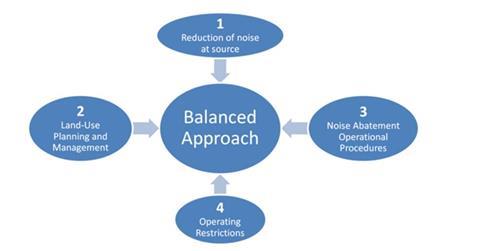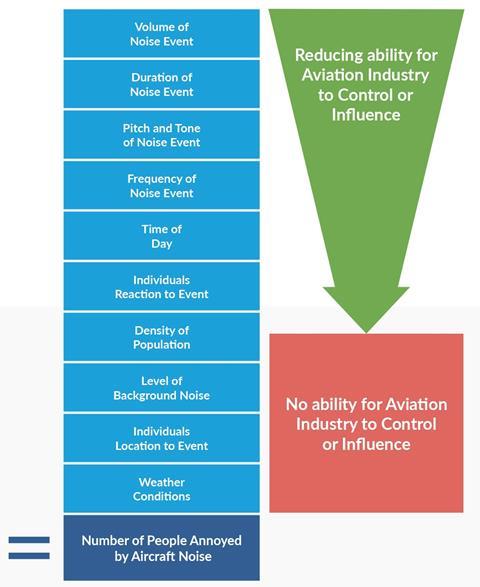European legislation is in place to ensure alternatives are explored to mitigate the impact of aircraft noise on communities before flights caps are implemented, but understanding when all such options have been exhausted is harder to judge, writes former director general of air traffic management trade body CANSO, Graham Lake
Aircraft noise is increasingly of concern for communities living near airports or under flight paths, despite the noise performance improvements of modern aircraft.
It is also a concern for the industry, as is clear from the legal battle that is playing out around Dutch government plans to cut flights at Amsterdam Schiphol airport. The move to limit flights to 440,000 a year from the start of the 2024/2025 winter season – 11% fewer flights than in 2019 – came with a stated objective to cut noise pollution. It drew praise from green groups but dismay from airlines bosses.

As an interim step toward that goal and to provide “certainty” for airlines and local residents, Schiphol sought to cut flights from 500,000 a year to 460,000 from the coming winter season.
This provoked a legal challenge by airline body IATA, home carrier KLM and several other of the airport’s operators. They argued that they can reduce noise levels and CO2 emissions while maintaining their passenger and cargo networks, having invested billions in the latest fuel efficient and quietest aircraft. They also highlighted Schiphol’s contribution to the wider Dutch economy.
At the beginning of April 2023, a Dutch court hearing the airline’s case blocked the interim move to cut flights from this winter. “The authorities had not followed correct procedure in enacting the decision”, the court in Amsterdam decided, scuppering for the time being one of Europe’s most high-profile government actions to reduce capacity on environmental grounds.
The court decision noted the need in regulation to exhaust all other noise mitigation methods and use of associated processes, before resorting to restrictions on flying. This is one of the key principles of EU598 legislation and its genesis in what is known as the ICAO Balanced Approach.

In order to address the effects of aircraft nose and reflecting the Balanced Approach to the Management of Aircraft Noise published by ICAO in 2001, the European Union implemented a series of regulations including EU598 legislation aimed at reducing aircraft noise and any adverse impact on local residents. This also set out the processes to be followed when considering restrictions to flying for noise reasons.
Significantly, this means that aircraft operators, airports, air navigation service providers and the local planning authorities – not just the aircraft operators – ought to be engaged in exploring all possible options for reducing noise and its impacts. That includes the evaluation of any potential economic and health factors, and to consult stakeholders using a process described in the EU598 regulations. Only then, can governments or airports reasonably resort to the restriction of flights for noise reasons.
The legislative approach is designed to balance the needs of aircraft operators and other aviation and economic stakeholders with the interests of local communities. While restrictions on flying may be necessary in some cases, the aim is to minimize their use through the adoption of effective noise abatement procedures, the use of quieter aircraft and other noise measures such as restricting the construction of new homes in areas likely to be adversely affected by aircraft noise and insulating those homes already constructed or planned.
As noted by the airlines that brought the Schiphol case to the courts, by working together, the aviation industry and local communities can find ways to manage aircraft noise and ensure that everyone can benefit from safe and sustainable air travel.
Although the ruling blocking a reduction of flights this winter represents a near term victory for airlines, the Dutch government is continuing is consultation on a move to restrict flights to 440,000 on a permanent basis from 2024 onwards.
In a sign that Schiphol airport’s operator recognises the prospect of punitive measures are inevitable at some point, Royal Schiphol Group has separately said it plans to ban on private jets and further restrict take-off and landing times in order to bring about a “quieter, cleaner and better aviation”. It also intends to abandon its Kaagbaan second runway and prohibit the noisiest aircraft. Observers may note that moving aircraft to other airports, a consequence of banning them at Schiphol, simply relocates rather than reduces noise.
NET ZERO PUSH WILL REDUCE NOISE
The mechanisms used to improve noise performance and to lessen the impact of noise are often linked to use of more efficient flight profiles. For instance, the continuous climb and descent trajectories, sought by the Single European Sky and requiring airspace modernisation, are intended to reduce both noise and emissions, the drive to net-zero will also reduce the levels of aircraft noise reaching the ground.
The prospect of government initiatives to restrict flying elsewhere in Europe and beyond cannot be ruled out, yet the aviation industry’s ability to control and influence aircraft noise impact has limits.
The UK aviation industry body Sustainable Aviation highlights the magnitude of the challenge faced by the industry at large.

Equally, experience elsewhere has tended to indicate that, there is room for improvement even at the most environmentally responsible of organisations.
Lessons learned by aircraft and airport operators, ANSPs, regulators and local planning authorities can inform others facing similar challenges. As observed by KLM in response to the Dutch court ruling, “We would rather co-operate with the other parties than face them in court.”
In almost every case, and even at Schiphol – traditionally a leading proponent of good governance in noise management – more can and should be done to reduce noise impacts. This is something that is more likely to be achieved through collaboration and transparency with aviation stakeholders, regulators and local planning authorities.
The challenge now for the Dutch government, for Schiphol and all involved in using and serving the airport, is how to determine fairly that all other noise impact measures have been exhausted, thereby justifying the introduction of restrictions to flying? How does the airline, airport, ANSP or planning authority demonstrate that further measures can still be taken and with what impact?
The airspace modernisation element is a good example. This inevitably long-term measure – which requires regulatory and policy support from government - will yield real benefits to both noise and emissions. Determining that all other measures have been exhausted is a complex requirement, it ought to be independently evidenced and verified. On what reasonable basis does a consultation call time on new measures and opt for restrictions?
Whether they like it or not, the aviation industry using Schiphol and elsewhere still faces these questions and should seek compelling and evidenced answers from governments and others involved.
About the author: Graham Lake has spent more than twenty years in international aviation policy advocacy, including a period as director general of CANSO, the trade association for air traffic management providers.


























